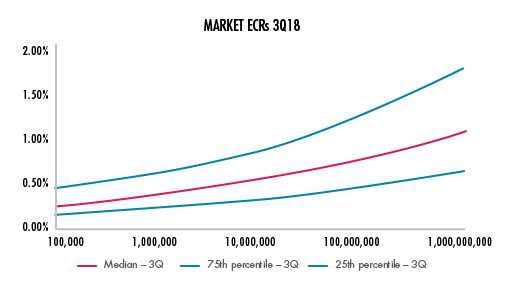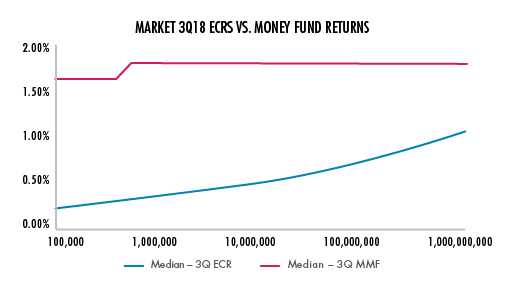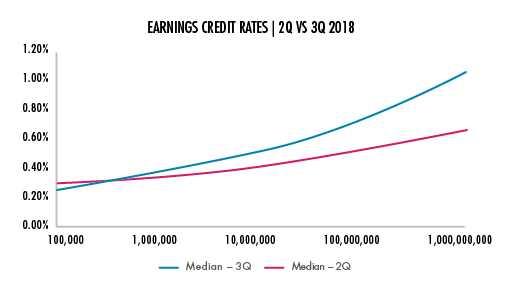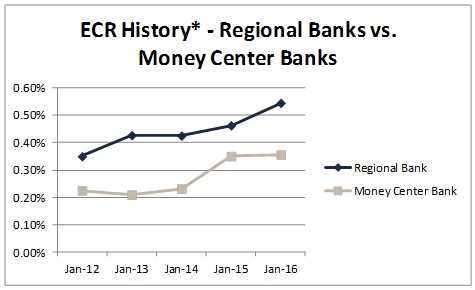Earnings Credit Rate

The earnings credit rate (ECR) is a banking metric that allows businesses to offset fees and service charges by earning credits on their account balances. This can be particularly beneficial for businesses with high transaction volumes and large account balances.
How does the Earnings Credit Rate work?
The Earnings Credit Rate is calculated based on the average daily balance of a business’s account over a specific period, typically a month. The bank applies the ECR to this average daily balance to determine the amount of earnings credits the business will receive.
Earnings credits are calculated as a percentage of the average daily balance and can be used to offset fees and charges incurred by the business. The specific rate at which the earnings credits are applied is determined by the bank and may vary depending on the account type and balance.
Benefits of utilizing the Earnings Credit Rate
There are several benefits to utilizing the Earnings Credit Rate:
- Cost reduction: By earning credits on their account balances, businesses can offset fees and charges, effectively reducing their overall banking costs.
- Flexibility: The Earnings Credit Rate provides businesses with flexibility in managing their banking expenses. They can choose to allocate the credits towards specific services or use them to offset fees across various banking activities.
- Maximizing financial resources: By utilizing the ECR, businesses can optimize their financial resources by minimizing unnecessary fees and charges, allowing them to allocate their funds towards other business priorities.
The Earnings Credit Rate is a percentage that is applied to the average daily balance in your account. This rate is then used to calculate the earnings credit, which can be used to offset various banking fees, such as transaction fees or monthly account maintenance fees.
Benefits of Earnings Credit Rate

1. Cost Reduction
One of the key benefits of ECR is cost reduction. ECR allows businesses to offset banking fees by earning credits based on their average daily balance. These credits can be used to reduce or eliminate fees associated with various banking services, such as wire transfers, cash management, and account maintenance.
2. Flexibility
ECR provides businesses with the flexibility to choose how they want to allocate their earnings credits. Unlike traditional interest-bearing accounts, ECR allows businesses to use their credits to offset fees instead of earning interest. This flexibility allows businesses to maximize the value of their banking relationship and tailor it to their specific needs.
3. Increased Cash Flow

By reducing or eliminating banking fees, ECR helps businesses increase their cash flow. With more cash on hand, businesses can invest in growth opportunities, pay suppliers and vendors, and meet other financial obligations. This increased cash flow can contribute to the overall financial health and success of a business.
4. Transparent and Predictable
ECR offers transparency and predictability in banking costs. Unlike traditional fee structures that can be complex and difficult to understand, ECR provides a straightforward metric for businesses to calculate and track their banking fees. This transparency allows businesses to better manage their finances and make informed decisions about their banking relationships.
5. Relationship Building
ECR can also help businesses build stronger relationships with their banks. By utilizing ECR, businesses can demonstrate their commitment to maintaining a healthy banking relationship and maximizing the value of their accounts. This can lead to improved customer service, access to additional banking products and services, and potential discounts or benefits.
| Benefits of Earnings Credit Rate |
|---|
| Cost Reduction |
| Flexibility |
| Increased Cash Flow |
| Transparent and Predictable |
| Relationship Building |
How to Calculate Earnings Credit Rate

Step 1: Determine the Average Daily Balance
To calculate the ECR, you first need to determine the average daily balance of your checking account. This is the sum of the closing balance at the end of each day over a specific period, usually a month, divided by the number of days in that period.
Step 2: Identify the Earnings Credit Rate
Next, you need to identify the Earnings Credit Rate provided by your bank. This rate is typically expressed as a percentage and may vary depending on the bank and the type of account you have.
Step 3: Multiply the Average Daily Balance by the Earnings Credit Rate
Once you have the average daily balance and the Earnings Credit Rate, you can multiply these two values together to calculate the earnings credit. This will give you the amount of credit that will be applied to offset banking fees or other charges.
Example:
Let’s say you have an average daily balance of $10,000 in your checking account and your bank offers an Earnings Credit Rate of 2%. By multiplying $10,000 by 0.02 (2%), you would earn $200 in earnings credit for that month.
Step 4: Understand the Application of Earnings Credit
Note: The specific details of how the earnings credit is applied may vary depending on the bank and account type.
Maximizing Earnings Credit Rate
Here are some tips to help you maximize your ECR:
- Optimize your account balance: Maintaining a higher average balance in your account can lead to a higher ECR. By keeping your account well-funded, you can earn more credits and offset your banking fees.
- Minimize idle funds: Avoid keeping excess funds in your account that are not generating any credits. Instead, consider investing or allocating those funds in a way that can earn you additional income.
- Explore cash management solutions: Work with your bank to explore cash management solutions that can help you optimize your ECR. These solutions may include sweep accounts, cash concentration, or other liquidity management tools.
- Review and negotiate fees: Regularly review your banking fees and negotiate with your bank to ensure you are getting the best rates and terms. By reducing your fees, you can increase your ECR and maximize your earnings.
- Stay informed: Stay up to date with industry trends and changes in banking regulations that may affect your ECR. By staying informed, you can adapt your strategies and take advantage of new opportunities to maximize your earnings.
By following these tips and implementing effective strategies, you can maximize your Earnings Credit Rate and make the most of your banking relationship. Remember, every dollar counts, and optimizing your ECR can have a significant impact on your bottom line.

Emily Bibb simplifies finance through bestselling books and articles, bridging complex concepts for everyday understanding. Engaging audiences via social media, she shares insights for financial success. Active in seminars and philanthropy, Bibb aims to create a more financially informed society, driven by her passion for empowering others.
